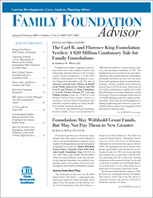How to Calculate a Foundation’s Annual Distribution Requirement—Part II
Author: Katherine E. David.
Source: Volume 16, Number 02, January/February 2017 , pp.1-4(4)

< previous article |next article > |return to table of contents
Abstract:
In order to ensure that assets held by non-operating private foundations actually are used to achieve an IRC §501(c)(3) purpose, IRC §4942 requires non-operating private foundations to make a certain amount of distributions each year. In simple terms, for each taxable year, a foundation must calculate its “distributable amount” and this amount must be distributed or used to achieve an IRC §501(c)(3) purpose before the first day of the second taxable year following that taxable year. (For example, a foundation that uses the calendar year must distribute its 2016 distributable amount before January 1, 2018.) When describing the annual distribution requirement, advisors often use a kind of shorthand—for instance, “the distributable amount as being roughly equal to 5% of the value of the assets in the foundation.” This description may be sufficient to alert foundation administrators to the fact that regular distributions must be made and to give them a sense of the magnitude of the required distributions, but the actual calculation is more complicated. This article, the second in a two-part series, describes which assets must be taken into account for purposes of calculating the minimum investment return, and which assets can be excluded from the calculation.Keywords: IRC §4942; Distributable Amount; Minimum Investment Return; Valuation of Assets
Affiliations:
1: Strasburger & Price, LLP.